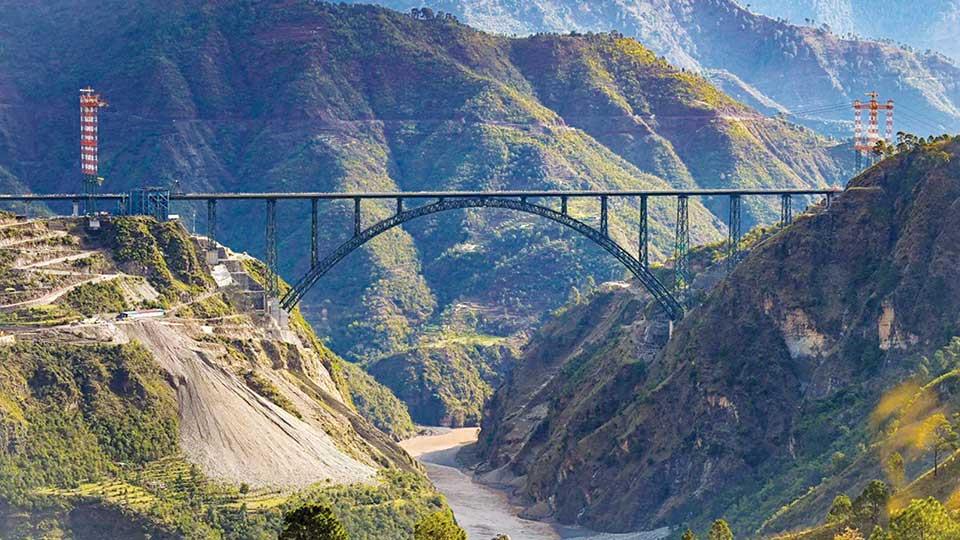
By Sana Hamid 17 June 2023
In a March press release, Indian Ministry of Railways relayed opening of Chenab river bridge by the end of December this year or by January 2024. The speculated project proclamations have run among the beleaguered populace of Indian Illegally Occupied Jammu and Kashmir a sense of fear and disentitlement as they see it as just another BJP’s tactics of furthering dampening their right to self- determination by intensifying their brutal control and subjugation in the heavy militarized valley.
“Connectivity will be a huge assistance to New Delhi in terms of control. I think that is their ambition”, Kashmiri academic and political analyst Siddiq Wahid told Al Jazeera.
The bridge over the Chenab River – 1.3 km (4,314 feet) long and 359-metre-high (1,177 feet) from the bed of the river-is part of a greater Udhampur-Srinagar-Baramulla Rail Link (USBRL), initially thought in 1999. Overall the entire railway project is 119 km long comprising 38 tunnels and 931 bridges. Chenab bridge is pivotal to this scheme and attempts to forcefully integrate Srinagar with mainland India, to the chagrin of the population of the region.
Prior to its construction, engineers had to make 26 km approach road and 400 m long tunnel to reach site of the bridge, with the ultimate aim of increasing surveillance and control over the territory. “India will use the bridge as a high-visibility, eye-catching data point to argue its strategy (of building peace in Kashmir) is working.”—Michael Kugelmann, director of the South Asia Institute at the Wilson Center shared.
While India boosts high of increasing trade avenues by virtue of such overtures but the mirror image shows rather drastic consequences. The bridge and the entire railway project, in general will also transform the security scenario with easy mobilization of supplies, troops and military equipment to the region.
“The train will help in bringing logistics and stocks for the army to Kashmir,” DS Hooda, former northern commander of the Indian Army proclaims.
This in other terms would mean aggravating Indian attempts in bringing further misery and remorse to the only Muslim majority region in India. Since the bridge is constructed over Jhelum, the construction also hints at manifestation of larger Indian Machiavellian politics at play. Such development projects targeting Jammu region, where Hinduism is practiced by some 63% of the population- Jammu and Kashmir, collectively has 68.3% of people adhering to Islam-might be observed as divide and rule strategy at play in the valley. The empowerment claims in this way might only target Hindu populace while socially and economically alienating Muslims of the region,
Empowering Hinduism adherents, exercising greater military control and surveillance and marginalizing Muslims seems yet another attempt at Balkanization of the valley, that stands in heinous violation of various UNSC resolutions as well as humanitarian laws.
The occupier force is forbidden from using occupant’s state land and natural resources for such purposes. The unlawful appropriation of property by an occupying power amounts to “pillage”, which is prohibited by both the Hague Regulations and Fourth Geneva Convention and is a war crime under the Rome Statute of the International Criminal Court and various other laws.
In the long run, the project if allowed to be commissioned and operational would also bring ecological harm to the Indus river waters. The project was halted in 2008-2009 primarily due to concern regarding high wind speeds and seismic activity in the area. It is stipulated that once completed, the bridge will have a lifespan of 120 years, so with short infrastructural lifespan, the project proficiency and used material efficiency is highly put into question, any shortcomings of which would mean polluting Chenab and hence Indus river system as bridge is composed of 28, 000 tons of steel.
The bridge is considered 30 meters taller than Eiffel Tower but while Eiffel is an element of grace and art, Chenab bridge and the entire railway system suggests to trespasses lengths of discord and disharmony as Indian attempts at changing demographics and topography of the South Asian region can yield drastic social, political, economic, environmental and regional consequences, to the benefit of none.
